Watch out – fake news !
PREMISE
Creating an interactive storytelling project thanks to which everyone can experience the power of fake news and learn new things about it.
SYNOPSIS
The time of spreading information, especially by the big sources is incredibly fast. Unfortunately justifying the wrong facts is a more complicated process and usually needs more time. That is why fake news is one of the biggest problems for the modern Internet nowadays. Fake news belongs to the field, forms of journalism, but for sure not to a professional one. It can influence people’s life or in general our world very much and can do it either globally or locally. “Fake news has taken off around the world” (Lees C., 2017) says a former Sunday Times correspondent Caroline Lees in her scientifical article about fake news and gives numerous cases of usage fake news by politicians from many countries.
In order to speak about the impact of fake news, there should be a good definition of this term. In the scientific journal „The science of fake news” described fake news as „fabricated information which mimics news media content in form but not in organisational process or intent” (Baum M.A., Benkler Y., Lazer D. M. J., 2018) The authors also mentioned tight overlapping with other information disorders such as misinformation and disinformation.
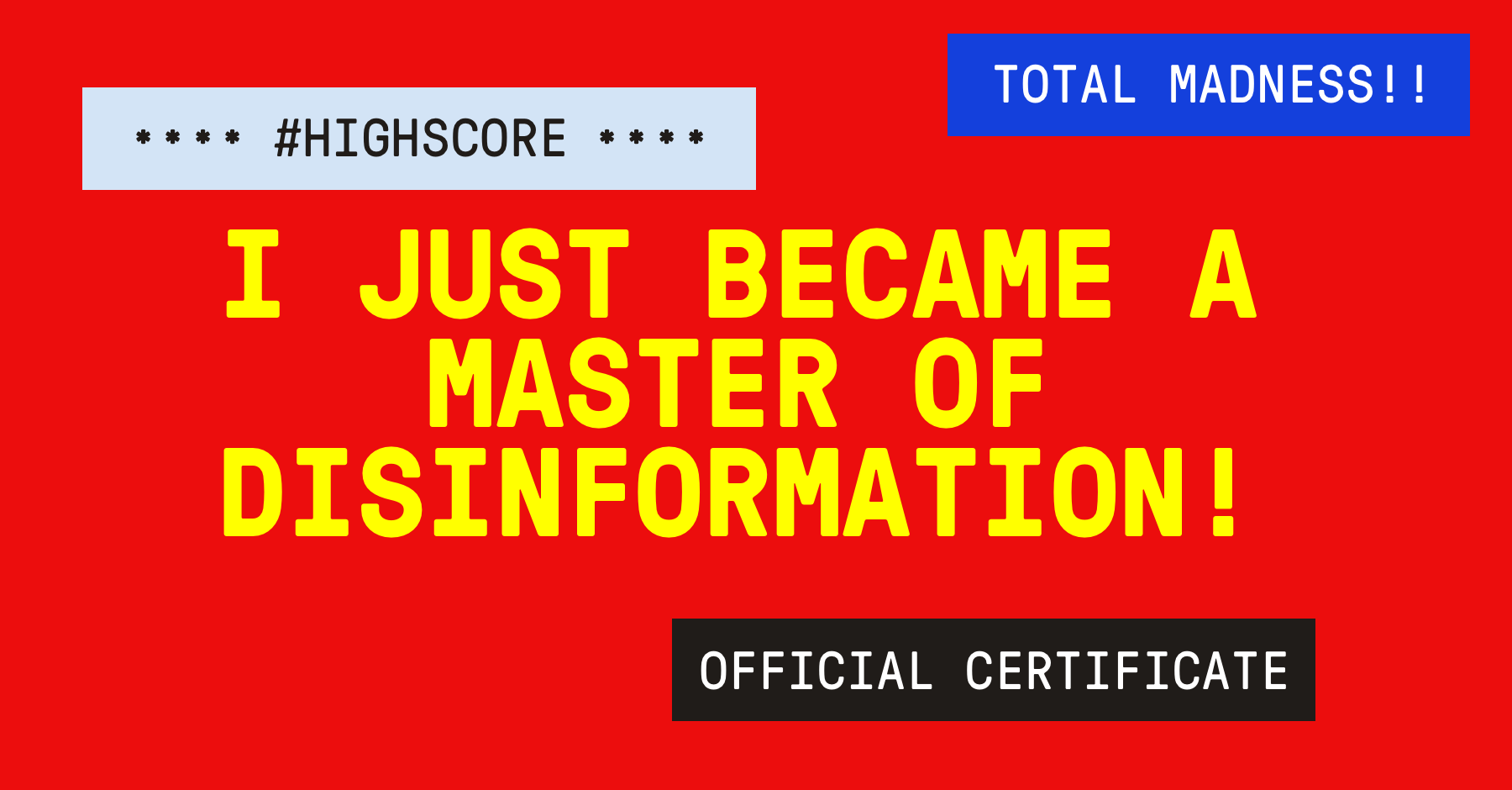
BACKGROUND
Lately fake news phenomenon got the most attention in the field of politics which occurs mostly on social media. It is a so-called new „political weapon” that brings rather negative results. For instance, spreading false information can lead to unfair elections, the lack of knowledge and hate towards a certain topic or any other governmental programs.
“(…) the fake news produced and published by mass communication vehicles such as social media, dominating traditional and social platforms, becoming increasingly part of many people’s daily lives.” (Rocha Y.M., de Moura G.A., Desiderio G.A., de Oliveira C. H., Lourenco F.D., de Figueiredo Nicolete L.D., 2021). Proving this hypothesis, „The science of fake news” published a case study about it. Allcott and Gentzow (2017) were evaluating the dissemination of prominent fake news stories (Boberg S., Frischlich L., Schatto-Eckordt T., Quandt T., 2019) and showed that „the average American encountered between one and three stories from known publishers of fake news during the month before the election 2016” ( Baum M.A., Benkler Y., Lazer D. M. J., 2018). There were also news on social media about the death of Hillary Clinton a couple of days before the election day which was supposed to disturb the American society (Morgan S., 2018). For sure, US elections in 2016 are a big and bright example of how much can be manipulated people’s opinion and how far it can lead to. This example also presents very clearly that fake news can be very common and filling up a lot of media communicators and sources.
Bringing people to more awareness and understanding what they see on the Internet is a solution to decreasing fake news. So during classes I came up to the idea of creating storytelling as a prototype for my project. Thanks to interactive kind of storytelling, every user would be able to play around with it .
RESEARCH AND EXPERIMENTATION
Problem: fake news has a big influence on our society because many people believe in them and it is not good.
Question: How can people become more aware of fake news? How can they learn more about its influence? Where should not I look for the information?
Answer: Fake news literacy. Knowledge about fake news which a person can learn at school so no matter what your higher education is, it will be a basic start for everyone from a younger age. This is the ideal scenario though. So to present this problem I decided to “tell” some imaginary story about it. My prototype which would include an interactive storytelling is not that perfect to be used for such a serious purpose but it can still learn people something and bring some fun during it.
Interactive storytelling is some kind of set of decisions which is mainly based on 3 levels such as: selection, specification and refinement. Their main role is shaping the general story on each of the stage by allowing people to take action during it (Bulitko V., Thue D., Spetch M., Wasylishen E., 2007). “We live and think the world within a story structure that is “brain-based and deeply human” (Young & Saver, 2001, p. 80) springing from the depths of the human psyche both individually and collectively.” (Lewis P.J., 2011, page 505). This is how the experience of going through storytelling is explained in one of the research papers about it. This statement was the basis which drove me through the whole creating story process. I wanted my users to move to another life, reality at least for short time by creating the storytelling about fake news from which I am the author. In case they never faced the problem like this, I created a situation which would be fully concentrated only on that. For sure the end of the storytelling is also very important. As every story based on a serious topic, it has to teach us something or just give a reason to reflect a bit more about certain things. “Every story comes to an end and in that ending it is possible to see things heretofore unnoticed; (…).” (Lewis P.J., 2011, page 506).
For creating my story I chose a platform called Twinery. I was advised about this program by my teacher. From the first look, the interface of it looked pretty simple and easygoing. While working in it, everything went smooth and I had no bugs to fix. Youtube tutorials made it easier for me. As I do not have any technical or design background it was a huge advantage for me. Because creating storytelling sounded as big a challenge for me. BUT. It was fun and interesting to learn new things. A bit more about how the creating process looked like:
- As a very true beginner, everything has started from YouTube tutorials for me. I watched many videos from the basic to more advanced level.
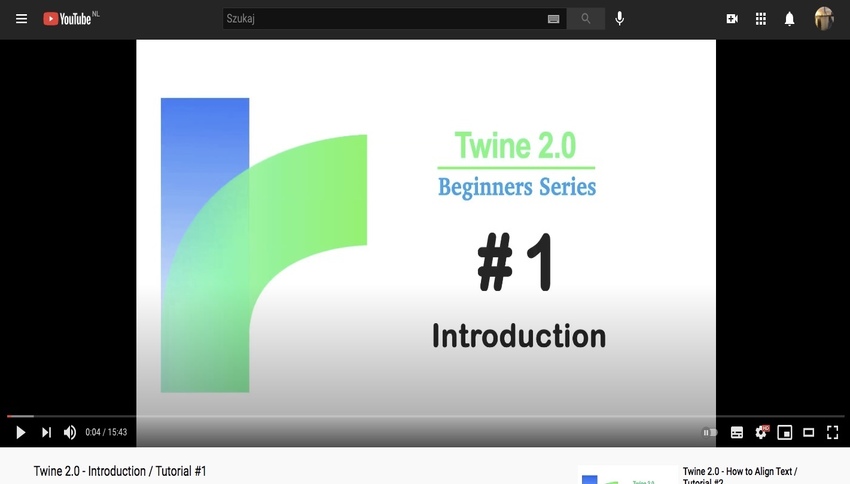

2. They helped me with making first steps in producing my project, like creating a folder which includes all the pages, creating a text for each page and making it more functional.

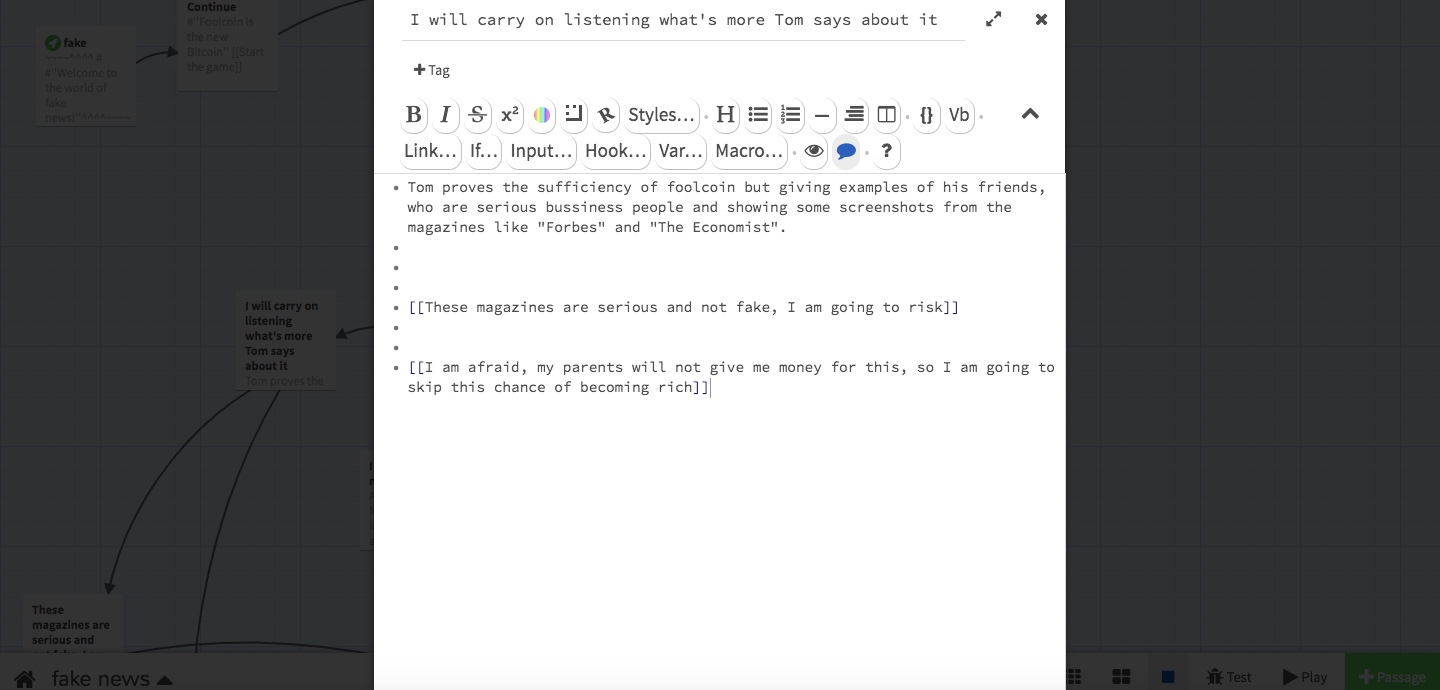
3. Some pages demanded extra code in order to paste in the images:
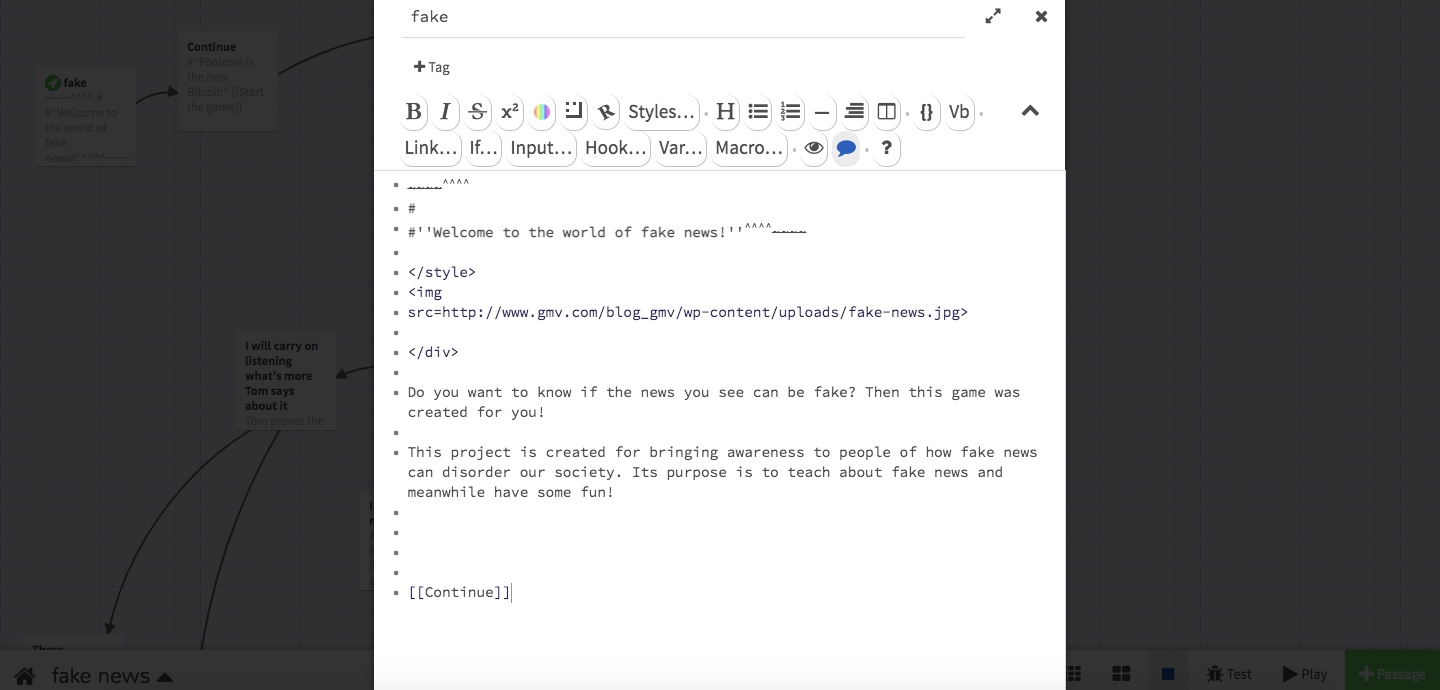
Also for editing the whole story like changing the background colour, font size and its colour, the colour of buttons, all changes had to be done in the stylesheet. Below you can see the code which I used for making these changes:
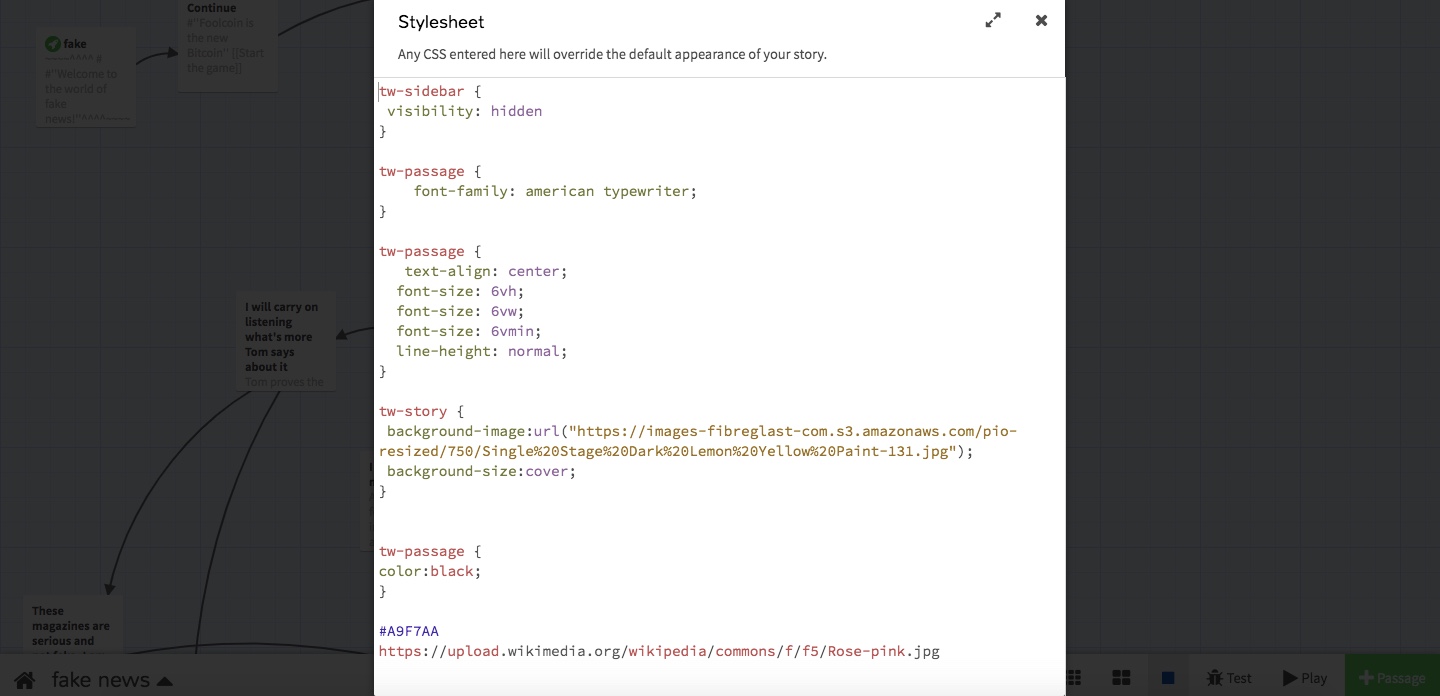
4. Voilà! First part of my work is done!

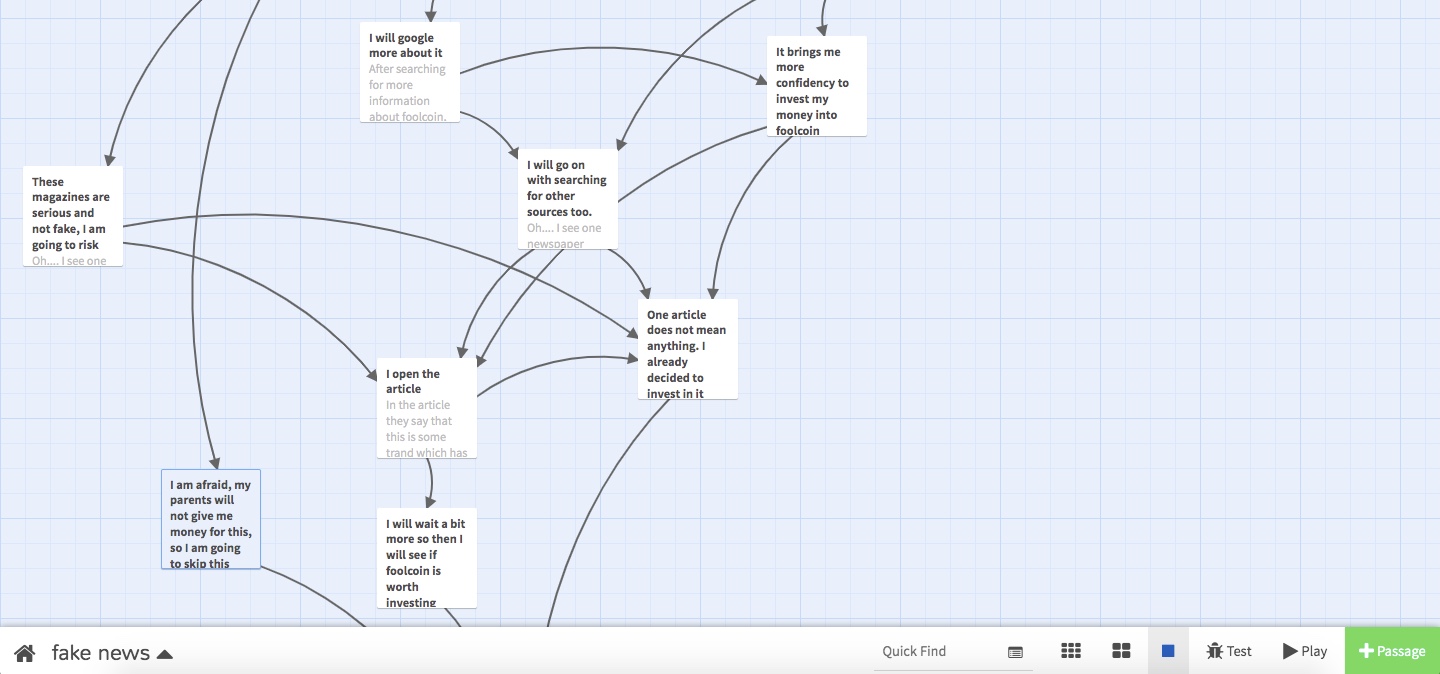

I called my storytelling “Foolcoin is a new Bitcoin’. In each part, users have to choose one out of two options in order to move forward through it. “Stories have characters that are human or human-like in their traits or perceptions, and they have events that follow along the lines of generic plots”(Poletta F., Callahan J., 2017, page:3). In order to create my storytelling, I had to implement into it a character. As a main and only personality, I created a fictional famous Youtube blogger named Tom Bernard who has a big supporting him audience. The storyline is based on him and his story which he tells to his fans and tries to make them believe it. It is based on financial investment into the fake cryptocurrency Foolcoin.
ITERATION #1
After building up the good story which can be interactive and interesting for my user, I started to work on the appearance of it.First version looked like this:

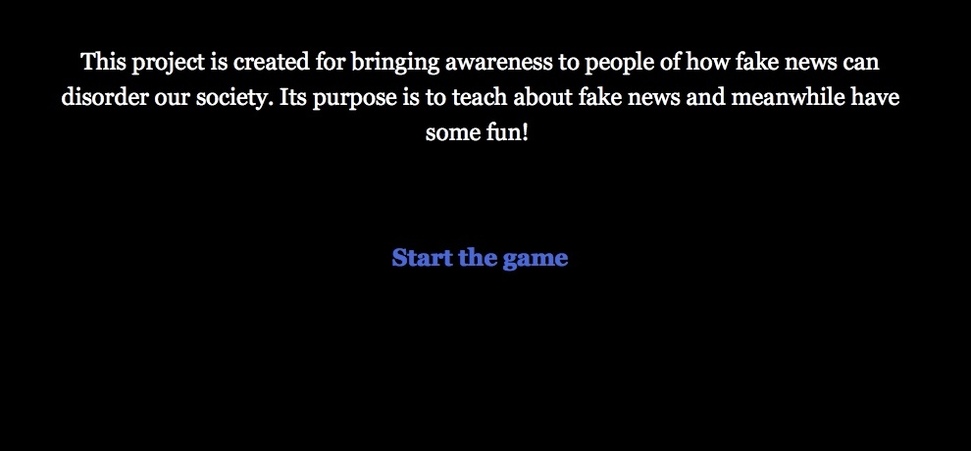
When the pilot version was done, it was time for the next step – user testing. Of course it was very important to hear the feedback from the “third person” which would help me to work on my mistakes. I sent a message to couple of friends of mine in order to hear their opinion. Any remark, feedback was good to hear for further improvement. I decided to do it in a text version so it is easier for me and later implement it here as screenshots.

Here are the reactions including remarks which were later implemented into my project. Firstly it was about the content. Some were about grammar and spelling mistakes and some were about their general perception of the storytelling:



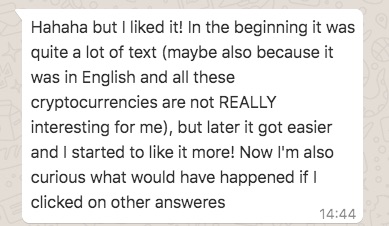
The first iteration was about the context of the storytelling. It helped me to see if a boring topic, as for some users, can still interest them under condition it is presented in a playful, funny way. Luckily for my friends it was good. Nevertheless, I still made some correction in the text after their feedback. The next for which I would go is improving the visual part of it.
ITERATION #2
After correcting mistakes and working on text, I started to experiment with colours. The basic version suggested by Twine looked to me too boring. I wanted to make it brighter so I was looking for the good colour combination. My goal was also to make the text readable. Here are happening some experiments with colours and font size, style.


Of course these experiments had to be tested by other users. Their feedback:




Second iteration was about the experimenting with colours and general appearance of the storytelling. I must admit it was also really a necessary part. It helped me by showing the direction which I had to use in order to move further with my design. As interactive storytelling is not only about the text. If it is boring for users eye, nobody will look at it. After bringing two sides together, it is time to show the final version of the storytelling.
ITERATION #3
In the end, after having a couple of feedback sessions from my test users, I created the final version. I went for the bright background yellow colour and classical black font. In my opinion it was perfect not too much striking and not too simple colour range. As you see, some parts of the text have bigger font size, which were used for the titles. Also I implemented users remarks about the content of the storytelling. Final version:


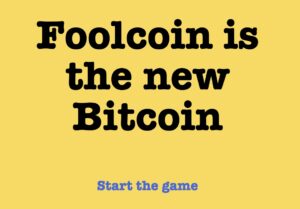
STORYTELLING OVERVIEW
Here you can see a short overview from the storytelling itself:
I also asked my friends who tested the previous versions of the storytelling for their general opinion. They seemed to like it and did not have any extra remarks about it. Looking at previous feedback, they also the idea in general and the way I decided to present the problem of fake news. As media get to have more and more influence on us nowadays, it is then also important to educate ourselves about “how to read them in a correct way?”.
CONCLUSION
While going through my interactive storytelling, users had a chance to believe in the fake news and see the results of it. Of course, they also had a chance to reject it. It was presented to them by, in their opinion, authoritative blogger with who they had some emotional connection. Of course it can recall some kind of trust from them towards him. Famous and influential people, their popularity, many positive comments, satisfied opinions from ordinary people, sufficient sources these were all driving tools to reach some certain goal but in the end were all fake.


As one of the options, in the storytelling it was suggested to share this fake news with others what would lead to disordering the Internet community and their online environment.
I created 2 endings, good and bad. The good one would just show the example of fakes news and give a lesson on being cautious in the Internet. The bad one would leave to a loss, doesn’t matter if it is a lot or just a bit of money. It would win them in the end.
Speaking about my self reflection about this project, here are the things I learnt or trained once again while making it:
- Basics how to design in interactive fiction programme.
- Design editing skills: changing the font size and colour, style, combing colours in CSS stylesheet.
- Creating storytelling.
- Training my research skills.
- Got deeper knowledge about storytelling and fake news.
- Worked with focus group while so-called ‘feedback session’.
Of course, as every project it can be always improved and continued. Here are the things which in my opinion, can be better:
- Design part. Add features which would make it look more professional.
- Make the story plot more interesting, exciting for users, possibly by adding more characters into it.
- Ask more precise, exact questions during user testing. Something for example: what options of the choice in the storytelling would you suggest? Do you always find them logical? How much authentic do you find this story?
REFERENCES
Baum M.A., Benkler Y., Lazer D. M. J., (2018). The science of fake news. Page: 1094–1095. Retrieved from: https://science.sciencemag.org/content/sci/359/6380/1094.full.pdf
Boberg S., Frischlich L., Schatto-Eckordt T., Quandt T., (2019). Fake News. Forms of Journalism. Retrieved from: https://onlinelibrary.wiley.com/doi/full/10.1002/9781118841570.iejs0128
Bulitko, V., Thue, D., Spetch, M., & Wasylishen, E. (2007). Interactive Storytelling: A Player Modelling Approach. Page: 43. Retrieved from: https://www.researchgate.net/publication/220978472_Interactive_Storytelling_A_Player_Modelling_Approach
Lees, C. (2017). Fake news: the global silencer. Page: 88. Retrieved from: https://journals.sagepub.com/doi/pdf/10.1177/0306422018769578
Lewis, P. J. (2011). Storytelling as Research/ Research as Storytelling. Page: 505. Retrieved from: https://journals.sagepub.com/doi/pdf/10.1177/1077800411409883?casa_token=9_bp-q317GUAAAAA:wfJqfYJFE72Mqf2FVgjwgtiksR-55A6_6pSf2PUCuM2bhmCWmpf8oKEbVTH4oiW_XE4DZ55VbFg
Lewis, P. J. (2011). Storytelling as Research/ Research as Storytelling. Page: 506. Retrieved from: https://journals.sagepub.com/doi/pdf/10.1177/1077800411409883?casa_token=9_bp-q317GUAAAAA:wfJqfYJFE72Mqf2FVgjwgtiksR-55A6_6pSf2PUCuM2bhmCWmpf8oKEbVTH4oiW_XE4DZ55VbFg
Poletta, F., & Callahan, J. (2017). Deep stories, nostalgia narratives, and fake news: Storytelling in the Trump era, Page: 3. Retrieved from: https://cpb-us-e2.wpmucdn.com/faculty.sites.uci.edu/dist/2/432/files/2011/03/Deep-Stories-Polletta-and-Callahan.pdf
Rocha, Y. M., De Moura, G. A., Desiderio, G. A., De Oliveira, C. H., Lourenco, F. D., & De Figueiredo Nicolete, L. D. (2021). The impact of fake news on social media and its influence on health during the COVID-19 pandemic: a systematic review. Retrieved from: https://link.springer.com/article/10.1007/s10389-021-01658-z
